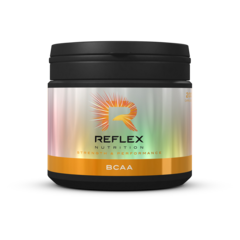Reflex Nutrition BCAA Review
BCAA is a supplement from UK based company Reflex Nutrition. The supplement description states that it can help aid recovery by increasing protein and nitrogen retention before and after exercise. This review will aim to understand how the product can achieve this by taking a closer look at the ingredients inside this supplement.
Ingredients
L-leucine/L-isoleucine/L-valine
Leucine, Isoleucine and Valine are all Branched chain amino acids (BCAA’s). They are essential for protein synthesis which is stimulated after exhaustive exercise (1) as well as the critical metabolic process in muscle (2, 3). The metabolic roles of Leucine include energy production and the modulator of muscle protein synthesis via the insulin signalling pathway. There is a reason to suggest that it helps maintenance of muscle mass during weight loss (4). Leucine has also been shown to help in the direct maintenance of glucose homeostasis by improving the redistribution of glucose via the glucose – alanine cycle (5).
Microcrystalline cellulose
Micro Crystalline Cellulose is a non-active ingredient which is made up of refined wood pulp. This substance doesn’t degrade during digestion and is preferable in tablets due to it being able to form hard but dissolve quickly.
Maltodextrin
Maltodextrin is a polysaccharide which is a complex carbohydrate. This ingredient is water soluble and unlike other carbohydrates, is easily digestible (6) and can give a quick release of energy without any spikes of glycaemia (7).
Magnesium stearate
Magnesium stearate does not induce any nutritional benefits. The main reason for this substance being in the supplement is that it is a lubricant for the machinery that manufactures the product.
Pyrodoxine hydrochloride
Pyridoxine hydrochloride is a form of Vitamin B6. The active form of vitamin B6 is known as P-L-P (8), which is stimulated by exercise (9). During exercise the body relies on the liver to produce glucose via glycogenolysis, for which vitamin b6 is essential for, and is an integral part of the glycogen phosphorylase enzyme and thus will provide energy to the bodies’ muscles (10).
Summary
Reflex Nutrition claims on its website that BCAA can help aid recovery. After reviewing the ingredients inside this supplement as stated on the website, alongside the relevant literature, it is clear to see that this product can achieve this. It is also useful for people looking to gain muscle mass also. This product can be taken pre workout (reduced fatigue), during exercise (muscle nourishment), and post exercise (recovery/repair). This product has no banned substances when referring to the WADA prohibited list when observing the label/ingredients posted on the website.
*NOTE – This product has not been tested in a laboratory and may contain other substances that may not appear on the label
References
1 – Coker, R. H., Miller, S., Schutzler, S., Deutz, N., & Wolfe, R. R. (2012). Whey protein and essential amino acids promote the reduction of adipose tissue and increased muscle protein synthesis during caloric restriction-induced weight loss in elderly, obese individuals. Nutr J, 11(1), 105.
2 – Hulmi, J. J., Lockwood, C. M., & Stout, J. R. (2010). Review Effect of protein/essential amino acids and resistance training on skeletal muscle hypertrophy: A case for whey protein.
3 – Pasiakos, S. M., McLellan, T. M., & Lieberman, H. R. (2015). The effects of protein supplements on muscle mass, strength, and aerobic and anaerobic power in healthy adults: a systematic review. Sports Medicine, 45(1), 111-131.
4 – Volek, J. S., Volk, B. M., Gómez, A. L., Kunces, L. J., Kupchak, B. R., Freidenreich, D. J., … & Kraemer, W. J. (2013). Whey protein supplementation during resistance training augments lean body mass. Journal of the American College of Nutrition, 32(2), 122-135.
5 – Hansen, M., Bangsbo, J., Jensen, J., Bibby, B. M., & Madsen, K. (2014). Effect of Whey Protein Hydrolysate on Performance and Recovery of Top-Class Orienteering Runners. International journal of sport nutrition and exercise metabolism.
6 – Haralampu, S. G. (2000). Resistant starch—a review of the physical properties and biological impact of RS< sub> 3. Carbohydrate polymers, 41(3), 285-292.
7 – Roberts, M., Lockwood, C., Dalbo, V. J., Tucker, P., Frye, A., Polk, R., … & Kerksick, C. (2009). Ingestion of a high molecular weight modified waxy maize starch alters metabolic responses to prolonged exercise in trained cyclists. In FASEB abstract.
8 – Ubbink, J. B., Vermaak, W. J., van der Merwe, A., & Becker, P. J. (1993). Vitamin B-12, vitamin B-6, and folate nutritional status in men with hyperhomocysteinemia. The American journal of clinical nutrition, 57(1), 47-53.
9 – Manore, M. M. (2000). Effect of physical activity on thiamine, riboflavin, and vitamin B-6 requirements. The American journal of clinical nutrition, 72(2), 598s-606s.
10 – Manore, M. N., Leklem, J. E., & Walter, M. C. (1987). Vitamin B-6 metabolism as affected by exercise in trained and untrained women fed diets differing in carbohydrate and vitamin B-6 content. The American journal of clinical nutrition,46(6), 995-1004.

| Use for | Recovery/Muscle Gain |
| Website | reflex-nutrition.com |
| Price | £24 – £47 |




